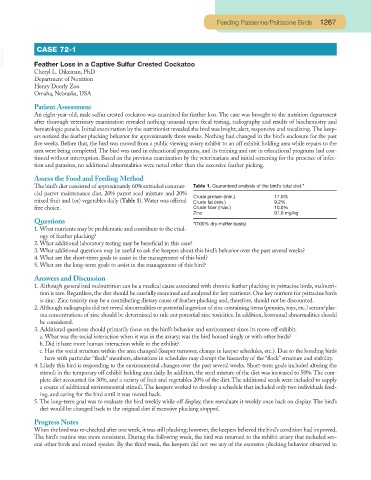Page 1217 - Small Animal Clinical Nutrition 5th Edition
P. 1217
Feeding Passerine/Psittacine Birds 1267
CASE 72-1
VetBooks.ir Feather Loss in a Captive Sulfur Crested Cockatoo
Cheryl L. Dikeman, PhD
Department of Nutrition
Henry Doorly Zoo
Omaha, Nebraska, USA
Patient Assessment
An eight-year-old, male sulfur crested cockatoo was examined for feather loss. The case was brought to the nutrition department
after thorough veterinary examination revealed nothing unusual upon fecal testing, radiography and results of biochemistry and
hematologic panels. Initial examination by the nutritionist revealed the bird was bright, alert, responsive and vocalizing. The keep-
ers noticed the feather plucking behavior for approximately three weeks. Nothing had changed in the bird’s enclosure for the past
five weeks. Before that, the bird was moved from a public viewing aviary exhibit to an off exhibit holding area while repairs to the
area were being completed. The bird was used in educational programs, and its training and use in educational programs had con-
tinued without interruption. Based on the previous examination by the veterinarians and initial screening for the presence of infec-
tion and parasites, no additional abnormalities were noted other than the excessive feather picking.
Assess the Food and Feeding Method
The bird’s diet consisted of approximately 60% extruded commer- Table 1. Guaranteed analysis of the bird’s total diet.*
cial parrot maintenance diet, 20% parrot seed mixture and 20%
Crude protein (min.) 17.0%
mixed fruit and (or) vegetables daily (Table 1). Water was offered Crude fat (min.) 9.2%
free choice. Crude fiber (max.) 10.0%
Zinc 91.0 mg/kg
Questions
*(100% dry matter basis)
1. What nutrients may be problematic and contribute to the etiol-
ogy of feather plucking?
2. What additional laboratory testing may be beneficial in this case?
3. What additional questions may be useful to ask the keepers about this bird’s behavior over the past several weeks?
4. What are the short-term goals to assist in the management of this bird?
5. What are the long-term goals to assist in the management of this bird?
Answers and Discussion
1. Although generalized malnutrition can be a medical cause associated with chronic feather plucking in psittacine birds, malnutri-
tion is rare. Regardless, the diet should be carefully examined and analyzed for key nutrients. One key nutrient for psittacine birds
is zinc. Zinc toxicity may be a contributing dietary cause of feather plucking and, therefore, should not be discounted.
2. Although radiographs did not reveal abnormalities or potential ingestion of zinc containing items (pennies, toys, etc.) serum/plas-
ma concentrations of zinc should be determined to rule out potential zinc toxicities. In addition, hormonal abnormalities should
be considered.
3. Additional questions should primarily focus on the bird’s behavior and environment since its move off exhibit.
a. What was the social interaction when it was in the aviary; was the bird housed singly or with other birds?
b. Did it have more human interaction while in the exhibit?
c. Has the social structure within the area changed (keeper turnover, change in keeper schedules, etc.). Due to the bonding birds
have with particular “flock” members, alterations in schedules may disrupt the hierarchy of the “flock” structure and stability.
4. Likely this bird is responding to the environmental changes over the past several weeks. Short-term goals included altering the
stimuli in the temporary off exhibit holding area daily. In addition, the seed mixture of the diet was increased to 50%. The com-
plete diet accounted for 30%, and a variety of fruit and vegetables 20% of the diet. The additional seeds were included to supply
a source of additional environmental stimuli.The keepers worked to develop a schedule that included only two individuals feed-
ing, and caring for the bird until it was moved back.
5. The long-term goal was to evaluate the bird weekly while off display, then reevaluate it weekly once back on display. The bird’s
diet would be changed back to the original diet if excessive plucking stopped.
Progress Notes
When the bird was re-checked after one week, it was still plucking; however, the keepers believed the bird’s condition had improved.
The bird’s routine was more consistent. During the following week, the bird was returned to the exhibit aviary that included sev-
eral other birds and mixed species. By the third week, the keepers did not see any of the excessive plucking behavior observed in

